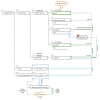A Novel Automated Mass Digitisation Workflow for Natural History Microscope Slides
- PMID: 30863197
- PMCID: PMC6408422
- DOI: 10.3897/BDJ.7.e32342
A Novel Automated Mass Digitisation Workflow for Natural History Microscope Slides
Abstract
The Natural History Museum, London (NHM) has embarked on an ambitious programme to digitise its collections. One aim of the programme has been to improve the workflows and infrastructure needed to support high-throughput digitisation and create comprehensive digital inventories of large scientific collections. This paper presents the workflow developed to digitise the entire Phthiraptera (parasitic lice) microscope slide collection (70,663 slides). Here we describe a novel process of semi-automated mass digitisation using both temporary and permanent barcode labels applied before and during slide imaging. By using a series of barcodes encoding information associated with each slide (i.e. unique identifier, location in the collection and taxonomic name), we can run a series of automated processes, including file renaming, image processing and bulk import into the NHM's collection management system. We provide data on the comparative efficiency of these processes, illustrating how simple activities, like automated file renaming, reduces image post-processing time, minimises human error and can be applied across multiple collection types.
Keywords: Phthiraptera; Data Matrix barcodes; automation; mass digitisation; microscope slides; natural history collections.
Figures







References
-
- Allan E. L., Price B. W., Shchedrina O, Dupont S, Livermore L, Smith V. S. A low cost approach to specimen level imaging of natural history microscope slides using a DSLR system. OSF Preprint. 2018 doi: 10.31219/osf.io/dvmsh. - DOI
LinkOut - more resources
Full Text Sources
